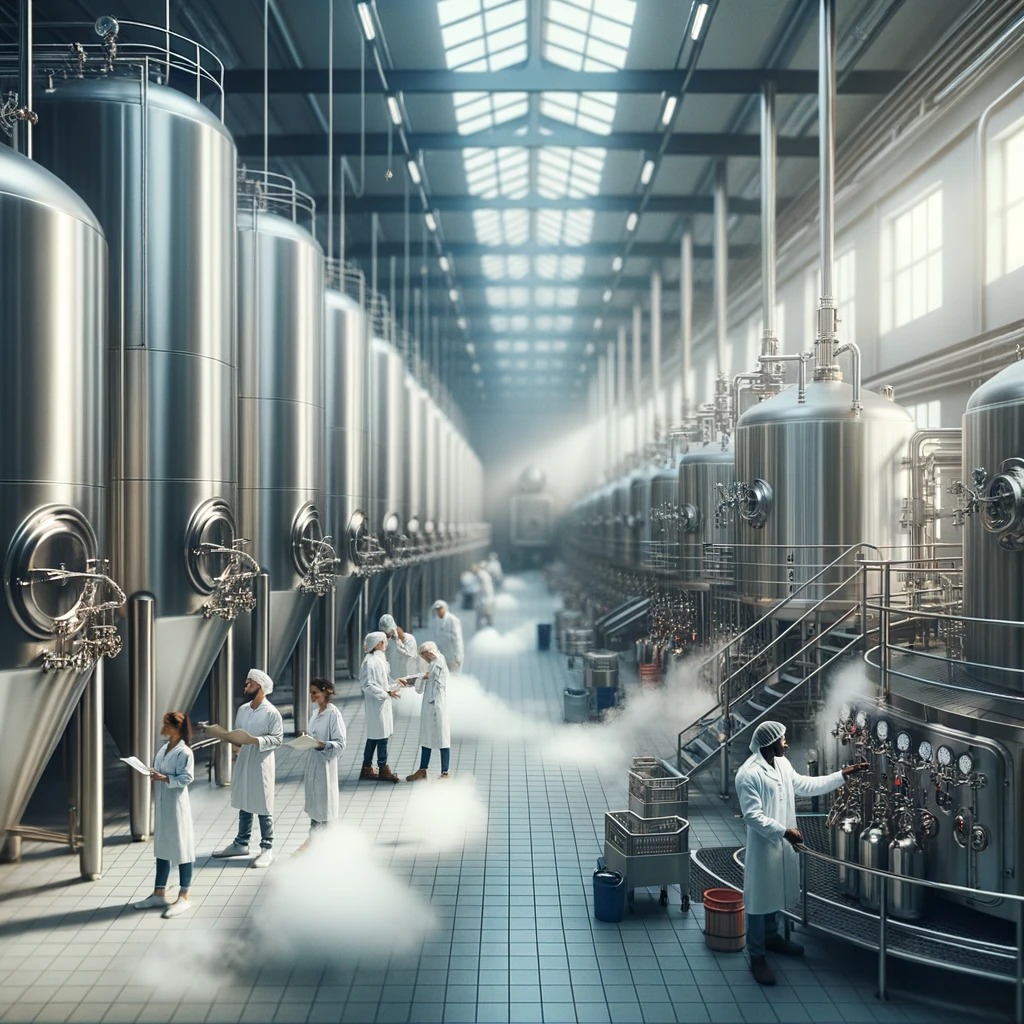
Welcome to this all-inclusive guide on what is fermentation. Whether you’re a student, a private teacher, a biochemistry tutor, or simply curious about the science behind everyday life, this guide has something for you. Fermentation is a captivating biochemical process with applications from your dining table to industrial factories. By understanding what is fermentation, you’ll gain valuable insights into anaerobic respiration, energy production, and much more. Don’t hesitate to contact a biochemistry tutor or a private teacher if you feel like you need additional help.
Here’s a glimpse of what you’ll learn:
- What is Fermentation and other fundamentals.
- The Biochemistry of Fermentation, focusing on enzymes and chemical reactions.
- Various Types of Fermentation, such as alcoholic and lactic acid fermentation, and their practical applications.
- Fermentation in Unexpected Foods and Beverages.
- The Industrial Importance of Fermentation, from biofuels to pharmaceuticals.
- How tutoring can assist you in understanding fermentation.
- Answers to Frequently Asked Questions about fermentation.
Want to expand your chemistry horizons? Our World of Chemistry offers a plethora of free educational blogs.
Are you interested in other subjects? We’ve got great free study guides for Biology, English, French, and Music.
What is Fermentation: A Comprehensive Learning Guide
Introduction to Fermentation: What It Is and Why It Matters
Fermentation is a metabolic process that converts sugars to acids, gases, or alcohol. It occurs in yeast, bacteria, and oxygen-starved muscle cells, as in the case of lactic acid fermentation. The process is ancient, dating back to when humans first started cultivating grains and producing beverages. Understanding what fermentation is can provide insights into how many everyday foods are made and also into a crucial biological process that allows organisms to generate energy in the absence of oxygen. It is a vital alternative energy-producing pathway in various organisms and has significant implications in food science and medicine.
The Importance of Fermentation in Modern Life
The importance of fermentation is multifaceted. It has been a cornerstone in food preservation for centuries, allowing for extended storage periods for essential items like milk and vegetables. Modern fermentation is critical in producing biofuels, pharmaceuticals, and waste treatment processes. On a biological level, it serves as an alternative metabolic pathway for cell energy production, particularly in anaerobic conditions.
Exploring the Different Varieties of Fermentation Processes
There are several types of fermentation, each with its unique characteristics and applications. Ethanol fermentation is commonly used to produce alcoholic beverages and bread. Lactic acid fermentation occurs in certain bacteria and animal cells, like muscle cells, and is responsible for products like yogurt and sauerkraut. Microbial fermentation is used to produce various drugs and vitamins, showcasing the versatility of this process.
Chemical Equation in Fermentation: A Simplified Overview
The general equation for fermentation is C6H12O6 → 2CH3CH2OH + 2CO2, which signifies the conversion of glucose into ethanol and carbon dioxide. This equation is a simplified representation but is a foundational understanding of how sugars are converted into different by-products.
Discover the fundamentals of Electrochemistry, Redox Reactions, and Balancing Chemical Equations.
What is Fermentation and The Biochemistry Behind It
Anaerobic Respiration: The Engine Behind Fermentation
Anaerobic respiration is a metabolic pathway that allows cells to convert nutrients into energy without using oxygen. This is especially important for organisms that live in environments where oxygen is scarce or absent. The process enables these organisms to produce ATP, the cellular currency of energy, through alternative means, ensuring their survival and functionality. Anaerobic respiration is often seen in microorganisms like yeast and certain bacteria, which can thrive in environments ranging from the bottom of a lake to the human digestive system.
Aerobic vs Anaerobic Respiration: A Comparative Analysis
In contrast to aerobic respiration, which is highly efficient but requires oxygen, anaerobic respiration is less efficient but more versatile. It allows organisms to adapt to various environmental conditions, from oxygen-rich to oxygen-poor. The adaptability of anaerobic respiration makes it a crucial survival mechanism for many organisms.
Key Enzymes in Fermentation: Catalysts that Drive the Process
Enzymes are biological catalysts that facilitate chemical reactions. In the context of fermentation, enzymes like pyruvate decarboxylase and alcohol dehydrogenase are critical. They accelerate the conversion of pyruvate, a product of glycolysis, into end products like ethanol or lactic acid. These highly specialized enzymes work in specific conditions, often sensitive to temperature and pH.
Introduction to Proteins, and Peptide Bonds.
| Enzyme | Function | Optimal Conditions |
|---|---|---|
| Pyruvate Decarboxylase | Converts pyruvate to acetaldehyde | pH 4-6, 25-35°C |
| Alcohol Dehydrogenase | Converts acetaldehyde to ethanol | pH 7-9, 20-30°C |
| Lactate Dehydrogenase | Converts pyruvate to lactic acid | pH 6-7, 30-40°C |
How Fermentation Contributes to Energy Production
Fermentation serves as a quick but less efficient means of energy production. Without oxygen, cells can still produce ATP through fermentation pathways. This is crucial for muscle cells when oxygen supply is limited during intense exercise. It’s also vital for microorganisms naturally residing in anaerobic environments, like certain bacteria in the human gut.
Valuable By-products of Fermentation and Their Applications
The by-products of fermentation, such as ethanol and lactic acid, have significant applications. Ethanol is a key ingredient in alcoholic beverages and is also used as a biofuel. Lactic acid is essential in the dairy industry, particularly in producing yogurt and cheese. It’s also used to manufacture biodegradable plastics and as a food preservative.
Introduction to Lipids and Fatty Acids.
Exploring the Different Types of Fermentation Processes: A Comprehensive Guide
Understanding Ethanol Fermentation: How Yeast Converts Sugars into Alcohol
Ethanol fermentation is one of the most common types of fermentation and is primarily carried out by yeast cells. It involves the conversion of sugars like glucose and fructose into ethanol and carbon dioxide. This process is widely used in producing alcoholic beverages such as beer and wine. In addition to its role in the food and beverage industry, ethanol fermentation is crucial in biofuel production, specifically in creating bioethanol, a renewable energy source.
Mastering the Art of Brewing: The Role of Ethanol Fermentation
In brewing, ethanol fermentation is the cornerstone process that transforms simple sugars into alcohol. The type of yeast used and the fermentation conditions can significantly impact the final product’s flavor, aroma, and quality, making mastering this process essential for brewers.
Delving into Lactic Acid Fermentation: From Dairy Products to Muscle Cells
Lactic acid fermentation is another prevalent form of fermentation commonly seen in producing dairy products like yogurt and cheese. It is carried out by lactic acid bacteria that convert lactose into lactic acid. This not only preserves the food but also adds a distinct tangy flavor. Lactic acid fermentation is also observed in muscle cells during intense exercise when oxygen levels are low.
The Dairy Industry’s Secret: How Lactic Acid Fermentation Shapes Our Food
In the dairy industry, lactic acid fermentation is essential to produce products like yogurt and kefir. The lactic acid produced during the process acts as a natural preservative and contributes to the texture and flavor of the product.
Microbial Fermentation in Pharmaceuticals: Producing Medicines and More
Microbial fermentation is a broad category that uses various microorganisms besides yeast and lactic acid bacteria to produce substances like vitamins, antibiotics, and enzymes. This type of fermentation is particularly important in the pharmaceutical industry, where it is used to produce a range of medicines and vaccines.
Pharmaceutical Applications: The Role of Microbial Fermentation in Medicine
Microbial fermentation is instrumental in producing antibiotics like penicillin and other essential medicines in the pharmaceutical industry. The process allows for the large-scale manufacture of these substances, making them a vital component in modern medicine.
Need help with biology topics? Explore our extensive collection of biology educational blog posts designed to simplify complex concepts for you. Whether it’s photosynthesis, osmosis, the intricacies of green algae, understanding bacteria and viruses, or delving into the fascinating world of genetics and cells, our resources have got you covered. Expand your knowledge and enhance your learning journey with us today.
| Type of Fermentation | End Products | Common Applications |
|---|---|---|
| Ethanol Fermentation | Ethanol, CO2 | Bread-making, Alcoholic Beverages |
| Lactic Acid Fermentation | Lactic Acid | Yogurt, Sauerkraut |
| Microbial Fermentation | Various (e.g., Vitamins, Antibiotics) | Pharmaceuticals, Supplements |
Fermentation in Foods: From Bread to Dairy and Global Cuisines
- Yeast Fermentation: Key for bread rising and alcohol in beer and wine.
- Dairy Fermentation: Extends shelf life and boosts nutrition in yogurt and cheeses.
- Fermentation in Traditional Cuisines: Used in traditional foods like kimchi and miso for flavor and nutrition.
Industrial Uses of Fermentation: Biofuels to Pharmaceuticals and Beyond
- Biofuels: Ethanol fermentation turns biomass into bioethanol, a green alternative to fossil fuels.
- Pharmaceuticals: Microbial fermentation is key for producing antibiotics and vaccines.
- Waste Treatment: Anaerobic digestion via fermentation reduces organic waste and generates biogas. Additionally, read about water pollution.
The Importance of Tutoring for a Comprehensive Understanding of Fermentation
Tutoring offers a unique and personalized approach to understanding the complex subject of fermentation. Whether you’re enrolled in biochemistry lessons or attending biochemistry classes, a private teacher can customize the curriculum to suit your individual learning style and pace. This tailored approach ensures that you not only grasp the basics but also understand the nuances of fermentation.
Moreover, tutoring allows you to delve deeper into the intricate biochemistry behind fermentation. Unlike traditional classroom settings, which often have a broad and fast-paced curriculum, a tutoring session can focus on specific topics that interest you. This could range from the role of enzymes in fermentation to the complexities of anaerobic respiration and microbial fermentation.
Beyond theoretical knowledge, tutoring provides an opportunity for hands-on learning. Whether you’re interested in the practical applications of fermentation, such as brewing beer, or understanding waste treatment processes, a tutor can guide you through these real-world applications. This enhances your learning experience and helps you retain the information more effectively.
Lastly, the interactive nature of tutoring sessions offers an excellent platform for clarifying doubts and asking questions. This ensures you understand fermentation comprehensively, making you well-equipped to apply this knowledge in various contexts.
Are you looking for a chemistry tutor? Enter “chemistry tutor Glasgow” or “chemistry teacher Sheffield” on your preferred tutoring platform, such as meet’n’learn, to find a teacher who can meet your specific needs.
If you thrive in group learning environments, search “chemistry classes London” or “chemistry lessons Manchester” online to discover local schools offering chemistry lessons.
Discover the chemistry behind Water, Photosynthesis, and Air.
Conclusion: The Multifaceted World of Fermentation
Fermentation is a fascinating and versatile biochemical process with applications from the food and beverage industry to pharmaceuticals and waste treatment. Understanding the science behind it can be complex, but you can comprehensively understand this subject with the right resources, including tutoring and biochemistry classes.
Whether you’re a student, a private teacher, a biochemistry tutor, or someone interested in sustainable technologies, the world of fermentation has something to offer you. Its principles are deeply rooted in biochemistry, and its applications are virtually limitless, making it a subject worth exploring.
Check out 8 Exciting Science Experiments for Kids and unravel The Greatest Discoveries in Biology.
Frequently Asked Questions: Clearing Up Common Queries About Fermentation
1. What is the Basic Principle Behind Fermentation?
The basic principle behind fermentation is the conversion of sugars into other compounds, such as alcohol or acids, by microorganisms like yeast or bacteria. This is an anaerobic process, meaning it occurs without oxygen.
2. How Does Fermentation Differ from Anaerobic Respiration?
While both are anaerobic processes, fermentation, and anaerobic respiration differ in their end products and energy yield. Fermentation typically produces alcohol or acids, while anaerobic respiration produces compounds like methane.
3. What are the Different Types of Fermentation?
The main types of fermentation are ethanol fermentation, lactic acid fermentation, and microbial fermentation. Each has its applications, ranging from food and beverage production to pharmaceuticals.
4. How is Fermentation Used in Biofuel Production?
Fermentation is used to convert biomass into bioethanol, a type of biofuel. Ethanol fermentation is the primary process used for this conversion.
5. Can I Learn About Fermentation Through Tutoring?
Absolutely, tutoring can provide a personalized and in-depth understanding of fermentation. Whether through biochemistry lessons or hands-on experiments, a tutor can guide you through the complexities of this subject.
Discover your ideal chemistry tutor at meet’n’learn and skyrocket your understanding to new heights!
References:
1. Frontiers
2. Britannica
3. Wikipedia



